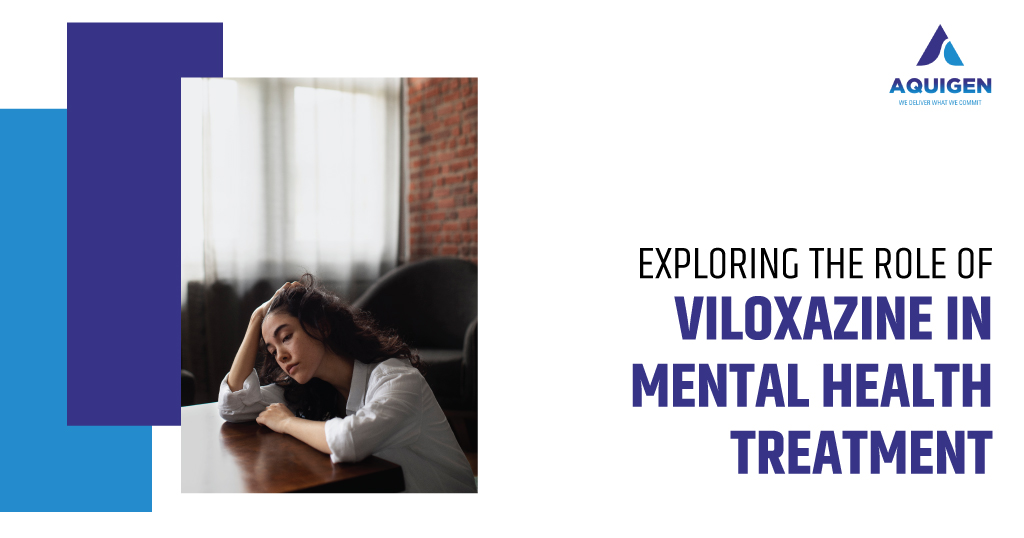Viloxazine is an antidepressant which was previously used for the treatment of depressive and anxiety disorders. In this blog, we will explore the role of Viloxazine in mental health treatment.
Viloxazine is a selective norepinephrine reuptake inhibitor (SNRI) that was previously used as an antidepressant in Europe. It belongs to a class of medications known as serotonin–norepinephrine reuptake inhibitors (SNRIs). Viloxazine works by increasing the levels of the neurotransmitters serotonin and norepinephrine in the brain. By regulating the levels of these important chemicals, it can help alleviate depression, and anxiety symptoms and improve mood. At Aquigen Bio Sciences, a leading Pharmaceutical API supplier, we can help you with Viloxazine API for drug development. But first, let’s understand viloxazine in detail and explore the role of viloxazine in mental health treatment.
Potential Benefits of Viloxazine in Mental Health
As an SNRI antidepressant, Viloxazine was found to have some potential benefits in treating various mental health conditions through its action on neurotransmitter systems in the brain:
Depression – Several clinical studies evaluated the efficacy of Viloxazine in patients suffering from major depressive disorder. It was observed to significantly reduce core symptoms like low mood, loss of interest, changes in appetite or sleep patterns and fatigue after some weeks of treatment. These benefits are thought to stem from Viloxazine’s ability to elevate levels of serotonin and norepinephrine in brain regions implicated in mood regulation.
Anxiety – Research including case studies and small controlled trials indicated Viloxazine may reduce symptoms of generalized anxiety disorder like excessive and uncontrollable worrying, restlessness and muscle tension. The precise mechanisms are not fully understood but adjusting neurotransmitter levels is believed to positively impact the neural circuits involved in fear and anxiety processing.
Panic disorder – Limited evidence from a few randomized controlled trials suggested Viloxazine 150-300mg per day could lower the frequency and severity of unexpected panic attacks, chest pain, dizziness or fear of losing control often seen in patients with panic disorder. The drug seemed to work via mechanisms targeting the interoceptive panic cues.
Obsessive-compulsive disorder (OCD) – Preliminary open-label and retrospective studies found Viloxazine treatment may result in diminishing obsessive thoughts and compulsive behaviours in OCD patients after 6-12 weeks. However, larger blinded trials were needed to draw definitive conclusions about its efficacy for this condition.
Side Effects and Discontinued Use of Viloxazine
All medications have the potential for adverse side effects. Viloxazine was no exception. Some of the common side effects reported with Viloxazine use included:
Nausea – Feeling sick to the stomach or an urge to vomit was a frequently reported side effect. This was usually mild to moderate in severity but could sometimes be unpleasant enough to affect patients’ quality of life. The exact mechanism for Viloxazine causing nausea is not fully clear but it is thought to be related to its effect on serotonin and norepinephrine levels in the gut.
Headaches – Mild to moderate tension-type headaches were commonly experienced by patients taking Viloxazine. It is hypothesized that altering neurotransmitter levels may lower pain thresholds and trigger headaches in susceptible individuals.
Insomnia – Disruption of normal sleep cycles and difficulty falling or staying asleep was observed in some patients. As Viloxazine increases wakefulness-promoting neurotransmitters, it may interfere with natural sleep mechanisms for certain people.
Sexual dysfunction – Problems like reduced libido, erectile dysfunction in men and difficulties reaching orgasm were seen more often with Viloxazine compared to placebo. The exact reasons are unclear but SNRI drugs are known to sometimes negatively impact sexual function.
Dry mouth – Feeling of dryness or discomfort in the mouth occurred commonly as a side effect. It is thought to be due to Viloxazine’s anticholinergic properties which reduce saliva production to some extent.
Additionally, it was found to prolong the QT interval on electrocardiograms in a few patients which could potentially cause heart rhythm issues. Due to its side effects and tolerability issues compared to newer drugs, Viloxazine was discontinued in the 1990s by most pharmaceutical companies and is no longer commonly prescribed by doctors. However, it continues to be researched for potential benefits in certain conditions.
Conclusion
In conclusion, Viloxazine was an early SNRI antidepressant which showed promise in treating various mental health conditions like depression and anxiety by regulating serotonin and norepinephrine neurotransmission in the brain. However, due to its side effect profile and issues with tolerability compared to newer antidepressants, it is no longer commonly prescribed. Aquigen Bio Sciences is a leading Pharmaceutical API supplier and provider of Viloxazine and its API impurities to support ongoing research in developing improved treatment options for mental illnesses. Feel free to get in touch with us and discuss your Viloxazine API impurities requirement. We are here to support your research and new drug development with our services.


